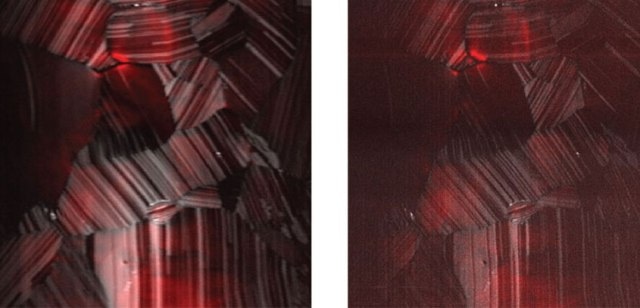May 27 2016
Extremely small biological structures such as viruses, proteins, and single molecules can now be visualized with the most sophisticated light microscopes in the world. However despite this advancement, even the very best microscopes are known to have certain limitations.
 Photoluminescence (red) and second harmonic generation (grayscale) from pure cadmium-telluride solar cells, imaged simultaneously. Standard resolution is on the left, and enhanced resolution, on the right, was captured by a CSU custom-built microscope. (Credit: Jeff Field)
Photoluminescence (red) and second harmonic generation (grayscale) from pure cadmium-telluride solar cells, imaged simultaneously. Standard resolution is on the left, and enhanced resolution, on the right, was captured by a CSU custom-built microscope. (Credit: Jeff Field)
Now, researchers at Colorado State University (CSU) have developed a new, customized microscope that pushes the limitations of super-resolution microscopy technique. This latest achievement could pave the way to light up separate cellular processes occurring in living tissues at unparalleled resolutions. The team has reported its study in the Proceedings of the National Academy of Sciences (PNAS) journal, with senior authorship by Randy Bartels, professor in the Department of Electrical and Computer Engineering, who holds mutual appointments in Chemistry and Biomedical Engineering.
Jeffrey Field is the first author of the paper and is also a research scientist in Bartels’ group and director of CSU’s Microscope Imaging Network (MIN). A Foundational Core Facility of university-wide instrumentation, MIN is managed by the Office of the Vice President for Research. The PNAS study was a multidisciplinary effort, which was also authored by postdoctoral researcher Scott Domingue and graduate student Keith Wernsing, along with research scientist Keith DeLuca in biochemistry and associate professor Jennifer DeLuca. The Catalyst for Innovative Partnerships project, supported by the Office of the Vice President for Research, seeded the partnership. The project aims at innovative methods for analyzing the human genome.
The limitations of standard techniques
The standard microscope has a resolving power, which is typically restricted by the way a light is focused tightly. This process is referred to as the diffraction limit. Such limitations can be overcome with the super-resolution microscopy method, which won the 2014 Nobel Prize in Chemistry. However in most of cases, accurate control of separate fluorescent molecules is needed to thwart the light’s diffraction limit. For instance, fluorescence is highly essential for biological imaging in a proven deep-tissue imaging method known as multiphoton microscopy. Although there are other kinds of image contrasts that offer critical data about a specimen, they are not suitable for use with traditional super-resolution techniques.
For the first time, the CSU researchers successfully showed super-resolved imaging through second-harmonic generation and multiphoton fluorescence at the same time. Second-harmonic generation is usually utilized in tandem with multiphoton fluorescence and occurs when a pair of photons is destroyed to produce one photon at double the frequency. Using a customized microscope, the CSU team showed resolving nanoscale images through second-harmonic generation. This microscope is built on a spatial frequency modulated imaging (SPIFI) method, which for five years, has been under development at Bartels laboratory. The team eventually attained spatial resolution which exceeded that of a traditional multiphoton microscope by utilizing multiphoton SPIFI (MP-SPIFI) microscope to concurrently obtain images via second-harmonic generation and multiphoton fluorescence.
In the case of traditional multiphoton microscopy, ultra-short laser pulses were centered on a tight spot on a sample, activating fluorophores to create an image. With the aid of the MP-SPIFI microscope, a relatively larger area is illuminated at the same time with many femtosecond laser pulses, producing the so-called interference pattern, which enabled the research team to create an image.
Unlabeled structures, unprecedented resolution
For PNAS, the MP-SPIFI microscope was demonstrated on standard biological samples known as HeLa cells as well as cadmium telluride-based solar cells. This capability to super-resolve with second-harmonic generation and other contrast mechanisms could provide a better understanding about various disciplines. This will ultimately allow scientists to image even unmarked structures with excellent resolution. The MP-SPIFI microscope is also capable of providing super-resolved images in highly dispersed biological tissues.
In a large number of super-resolution methods, cells have to be fixed to glass slides and hence, it is not possible to use in living tissues. The latest technique developed by the CSU team could enable in vivo super-resolution microscopy, or within bigger biological tissue specimens. Field and Bartels emphasized that significant amount of biological information can be acquired by improving the resolution of images acquired from in vivo specimens as well as by using different contrast mechanisms concurrently.
If we can do this below the surface of a biological sample such as live tissue, that is the utility of this. We can beat the diffraction limit of a canonical two-photon microscope.
Randy Bartels, Professor, CSU